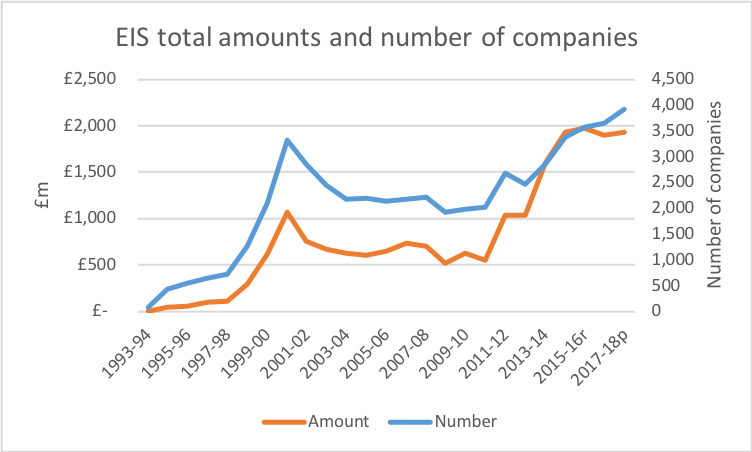Having taken a break I’m a little behind on some news. Last week HMRC published its annual statistics for EIS, which showed another record year for investment. The figures are for the 2017/18 tax year and showed:
- £1,929m raised by 3,920 companies through EIS (up 1.4% and 7.3% on 2016/17)
- £189m raised by 2,320 companies through SEIS (up 1.1% and down 4.3% on 2016/17)
- £1.4m raised by 20 social enterprises through SITR (down 44% and 33% on 2016/17).
However, HMRC note all these figures are likely to be revised upwards as further applications come in. While this was particularly noted for SITR, the projection for EIS is £2,041 for 4,130 companies. This would mean an increase of 7.4%, which is definitely a more significant figure.

So although the headline funds raised are a record amount, it isn’t a big increase over the previous year. Interestingly the HMRC report shows that the total amount raised in EIS has been just under £2bn for the last four years, but the number of companies has gone from 3,380 in 2014/15 to (projected) over 4,000.
This is very easily explained – the amounts raised for energy companies prior to the rule changes were significantly larger than the average. Many were close to or at the £5m limit. A similar pattern applied to many of the “capital preservation” products. Growth companies tend to be more variable in their funding requirements, including more smaller amounts. So the rising number of companies perhaps suggests more going to growth business.
What’s not in the figures
While these are interesting, the hot topic is what what happened in the 2018/19 tax year. Given the rule changes that took effect in early 2018, the EIS market has seen some dramatic shifts. The capital preservation products have gone, and the question was whether this money would disappear from the EIS market or go to growth companies?
The answer appears to be both! Mark Browridge at EISA estimates that the amount invested through EIS will be down about £350m in 2018/19. Given capital preservation offers appear to have exceeded that amount (the Patient Capital Review suggested over £850m) that is a very positive result. It means that, as I surmised a few weeks ago, the amount of money going into growth companies has risen. I expect the fall in the number of companies is much smaller than the estimated 17% fall in amounts invested.
It is not all good
One of the aims of the recent rule changes was to speed up the process of getting Advanced Assurance (AA). Chatting around the market, I am getting mixed impressions on whether this is happening. Some fund managers tell me that it is working, but others are still frustrated.
The statistics for AA apply to 2018/19, but are not clear. There is a fall in the number of applications (14% to 3,270 for EIS), but also in the acceptance rate (69% to 62%). SEIS figures show a similar pattern. A drop off in the acceptance rate is no surprise as there would be some adjustment needed after the new rules came in. But, the fall in application numbers should have facilitated faster processing.
My understanding is that HMRC has spent some time trying to understand what they are going to accept in some areas, particularly media. I’m aware of applications taking several months and it has been clear the HMRC team’s thoughts have been evolving. Hopefully, HMRC is now clear on the boundaries of acceptability are set now and the promise of fast times will be true for everyone.
Location, location, location
The other area of disappointment is the geographic focus, with 67% of EIS investment going to London and the South East. This is terrible. I know EISA has done some roadshows to raise the profile of EIS around the country, but more needs done. The fund managers I speak to who look outside the south-east are finding plenty of opportunities. And they tell me the valuation of investments is much more attractive too! My impression is that it is not the lack of businesses to invest in, but the focus of capital that is the issue. I have no silver bullet to fix this, other than encouraging those based on London to get on a train more 😛
Nevertheless, these feel like problems of success. Let’s hope 2019/20 shows more progress in funding the future growth businesses the country needs.